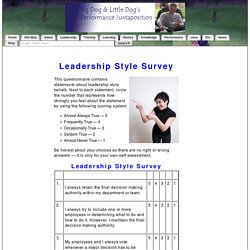Zoom
Trash

The Learner’s Dimension. BackgroundViewPoints on Style - BackgroundViewPoints on Style.pdf. Personality styles – are you red, green, yellow or blue? Melanie Benson Strick has written a blog post about something I found very useful when I took her course on virtual teams… A color wheel called Insights™ Discovery that illustrates the different styles people have of communicating and managing and processing information.

There are all kinds of personality tests out there – Myers Briggs is one; the HOTS (Hare, Owl, Tortoise, Squirrel) survey from Robert Allen’s One Minute Millionaire is another. But I like the color wheel – I find it very simple and easy for people to grasp and use. When you understand that the person you are managing (or outsourcing to) is a “green,” for instance, it makes it a lot easier to communicate in a way that is effective and productive. And since the personality types tend to correspond with career choices, once you learn how to communicate to a “blue” personality, you can use it with all the blues you run into (who probably include your bookkeeper, accountant, and maybe your project manager).
Strengths Homepage. Leadership Style Survey. This questionnaire contains statements about leadership style beliefs.

Next to each statement, circle the number that represents how strongly you feel about the statement by using the following scoring system: Almost Always True — 5 Frequently True — 4 Occasionally True — 3 Seldom True — 2 Almost Never True — 1 Be honest about your choices as there are no right or wrong answers — it is only for your own self-assessment. Leadership Style Survey In the table below, enter the score of each item on the above questionnaire. This questionnaire is to help you assess what leadership style you normally operate out of. The highest of the three scores in the columns above indicate what style of leadership you normally use — Authoritarian, Participative, or Delegative. The lowest of the three scores is an indicator of the style you least use. Final Thoughts Normally, some of the best leaders operate out of the participative mode and use the other two modes as needed.
Reliability and Validity Next Step. MBTI Personality Types. Feedback to See How Others See Me - The Clemmer Group. "Hearing 'reflective back talk' from friends, colleagues, spouses, and significant others allows us to "true" ourselves in relation to their perceptions.

With this input we can integrate our internal conversations with data from the external world to enrich the process of knowing ourselves better. " — Warren Bennis and Joan Goldsmith, Learning to Lead An elderly gentleman went to the doctor with a complaint about a gas problem. "But," he told the doctor, "it really doesn't bother me too much. When I pass gas they never smell and are always silent. As a matter of fact, I've passed gas at least 10 times since I've been here in your office. "I see," the doctor replied as he examined him. The next week the gentleman was back. The doctor retorted, "Good! An extremely useful step in our leadership development is seeing myself as others see me. The discussion of perceptions is often a thorny one as we work with individuals, teams, and organizations to improve their effectiveness. Leadership development and personal effectiveness.
Personality test based on C. Jung and I. Briggs Myers type theory. MBTI Basics - The 16 MBTI Types. Quiet, serious, earn success by thoroughness and dependability.

Practical, matter-of-fact, realistic, and responsible. Decide logically what should be done and work toward it steadily, regardless of distractions. Take pleasure in making everything orderly and organized - their work, their home, their life. Value traditions and loyalty. Quiet, friendly, responsible, and conscientious. Seek meaning and connection in ideas, relationships, and material possessions. Have original minds and great drive for implementing their ideas and achieving their goals. Tolerant and flexible, quiet observers until a problem appears, then act quickly to find workable solutions. Quiet, friendly, sensitive, and kind. Idealistic, loyal to their values and to people who are important to them. BELBIN®: The home of Belbin Team Roles.